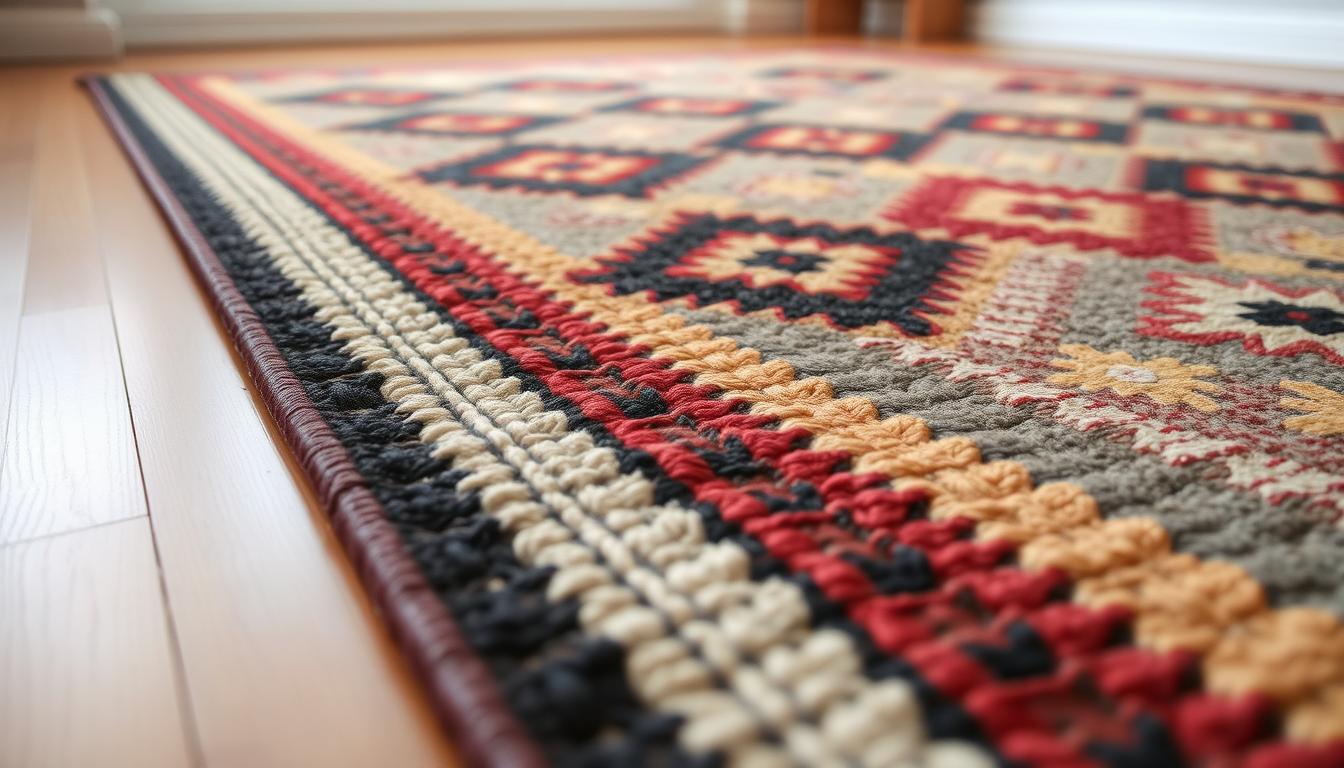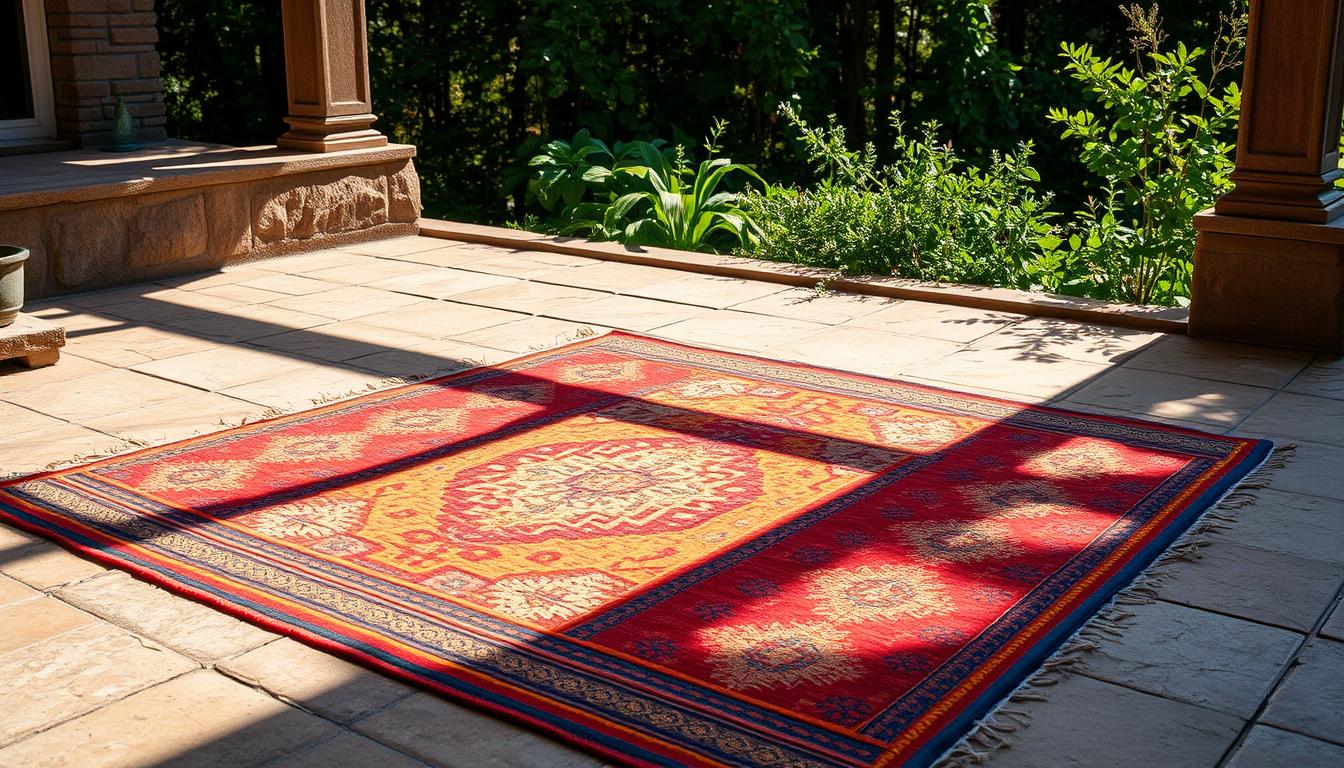
Kilim Rug Care: 5 Trusted Tips to Protect the Weave
These artisanal flat-weave textiles carry more than bold patterns—they preserve generations of craftsmanship from Turkey to Morocco. Unlike standard carpets, their tight, pileless construction demands a radically different approach to maintenance. One misstep could fade vibrant dyes or strain delicate fibers woven by hand.

Traditional cleaning methods often backfire on these cultural treasures. Harsh chemicals? They strip natural dyes. Vigorous scrubbing? It risks unraveling intricate motifs. Even routine vacuuming requires specific techniques to safeguard the weave.
But here’s the good news: mastering five core principles lets you protect both the artistry and longevity of these pieces. From step-by-step cleaning guides to climate control tactics, you’ll discover how to honor centuries-old traditions while keeping your space stylish.
Key Takeaways
- Flat-weave textiles require specialized maintenance to protect cultural heritage
- Standard carpet cleaning methods can permanently damage delicate fibers
- Five foundational care principles prevent color fading and structural harm
- Regional craftsmanship from artisanal hubs demands tailored preservation
- Proper techniques extend lifespan while maintaining vibrant designs
Understanding Your Kilim Rug
Crafted without a single knot, flat-woven pieces rely on precise tension between warp and weft threads. This structural choice creates durable surfaces perfect for high-traffic areas. Unlike plush carpets, debris sits atop the weave rather than sinking into layers.
Decoding Weaving Heritage
Artisans interlace horizontal and vertical threads using methods perfected over centuries. Wool dominates these creations due to its natural resilience against stains and moisture. Regions like Anatolia often use pure wool threads, while others blend cotton for structural contrast.
Material Matters Most
Your textile's longevity depends on recognizing its components. Check edges and fringes – cotton often reinforces these areas but shrinks if washed improperly. When 78% of vintage pieces show wool-based construction, matching cleaners to fiber content becomes essential. Test unknown blends in hidden corners before full application.
Two key considerations emerge: wool repels spills naturally but needs pH-balanced solutions, while cotton demands cooler temperatures during maintenance. Always prioritize gentle brushing over abrasive scrubbing to protect intricate motifs.
Preparing Your Kilim Rug for Cleaning
Before diving into maintenance, proper groundwork protects both materials and designs. Start by gathering these essentials: a vacuum with brush attachment, mild detergent, soft-bristle brush, cold water, and white towels. Missing just one item could compromise your entire process.

Eliminate Surface Contaminants First
Take your piece outdoors and shake it firmly but carefully. This removes up to 40% of loose dirt before deeper cleaning. For stubborn debris trapped in the weave, use short vacuum strokes on both sides with the brush attachment. Always move in the direction of the pattern to avoid fiber displacement.
Verify Color Stability
Mix a small amount of detergent with cold water. Dampen a white towel corner and gently press it against a hidden area for 10 seconds. Check for dye transfer – even slight discoloration means you'll need specialized methods from this step-by-step cleaning guide.
| Step | Tool | Time Required | Success Indicator |
|---|---|---|---|
| Dust Removal | Outdoor Space | 5-7 minutes | No visible particles falling |
| Vacuuming | Brush Attachment | 3 mins/side | Uniform surface texture |
| Color Test | White Towel | 2 minutes | Zero dye transfer |
Allow at least 30 minutes for these preparatory steps. Rushing increases risks of water damage or color bleeding. Remember: thorough groundwork makes subsequent cleaning stages more effective while preserving structural integrity.
Kilim Rug Care: Effective Cleaning Methods
Proper care techniques preserve intricate designs and durability in these artisanal pieces. Specialized approaches prevent damage to delicate fibers while removing embedded dirt. Start by reviewing your tools – using the wrong equipment risks permanent harm.
Smart Vacuuming Practices
Always use low suction settings on your machine. High power can stretch fibers or distort patterns. Disable rotating brushes – their agitation weakens the weave over time.
Clean both surfaces thoroughly. Flip the piece and repeat the process, moving parallel to the threads. Pay extra attention to edges, but avoid direct contact with fringes. Use a soft-bristled tool instead for these delicate areas.
Hand-Washing Techniques
Mix ½ cup mild detergent with 4½ cups cool water. Add 1 tablespoon white vinegar – its acidity locks in colors while breaking down grime. Test this solution on hidden corners first.
Apply the mixture with vertical strokes using a clean sponge. For stubborn spots, gently work a soft brush along the weave direction. Blot immediately with dry towels to prevent moisture buildup.
Need precise measurements? Our step-by-step cleaning guide ensures proper dilution ratios. Always finish by air-drying flat in shaded areas to maintain structural integrity.
Drying Techniques to Maintain Your Rug's Integrity
Proper drying prevents structural issues and color loss in flat-woven textiles. The final stage demands precision – moisture trapped in fibers can lead to irreversible damage if rushed. Strategic placement and timing ensure your piece retains its original beauty for decades.

Smart Space Selection
Choose a shaded, well-ventilated area with airflow on multiple sides. Lay the textile flat on an inclined surface like a clean rack or sloped patio. This position lets water drain while preventing warping. Grass or gravel bases work best outdoors – they support weight evenly and absorb excess moisture.
Sunlight Management Strategies
While sunlight speeds drying, UV rays fade dyes within hours. If using outdoor areas, limit exposure to early morning or late afternoon sun. Rotate the piece every six hours to ensure even drying without color bleaching. For delicate pieces, consider professional drying services that control light and humidity levels.
Patience proves critical – rushing with heat sources risks shrinkage or fiber damage. Most pieces require 24-48 hours to fully dry. Test by pressing a white towel against hidden sections; moisture marks mean more time needed. Avoid foot traffic until completely dry to prevent permanent impressions in vulnerable fibers.
Ongoing Maintenance and Preservation
Preserving handwoven textiles requires consistent attention to detail. Strategic habits prevent premature wear while maintaining vibrant colors and structural integrity. Let’s explore methods that keep your piece looking fresh for decades.
Rotating and Protecting High-Traffic Zones
Flip your textile’s position every 3-4 months. This simple act distributes foot traffic evenly across the weave. Focus on areas near doorways or furniture legs where damage fibers often begin.
Add non-slip pads beneath your piece. Quality cushions reduce friction against hard floors by 60%, preventing frayed edges. Choose natural rubber options without adhesives to avoid residue buildup.
Expert Intervention and Storage Solutions
Schedule professional rug cleaning every 12-18 months. Specialists use pH-neutral solutions that lift embedded dirt without harming dyes. This process removes allergens while restoring original texture.
When storing, roll your textile with acid-free paper inside. Never fold – creases weaken fibers over time. Keep it in a climate-controlled space away from direct light to prevent fading.
Act fast on spills to avoid permanent stain marks. Blot liquids immediately with white cloths, working from edges inward. For stubborn spots, consult our step-by-step cleaning guide before attempting DIY fixes.
Conclusion
Your textile’s enduring beauty relies on tailored care strategies rooted in tradition. By mastering these five methods—from preventive maintenance to climate-aware storage—you honor generations of craftsmanship while safeguarding vibrant patterns.
Act swiftly on spills using pH-neutral solutions, and always test cleaning agents in hidden areas first. For persistent stains or delicate pieces, consult our specialized cleaning guide to avoid irreversible damage. Rotate your piece seasonally to distribute wear evenly across fibers.
Professional services every 12-18 months lift embedded dirt without harming natural dyes. When storing, roll—never fold—the textile and use acid-free paper to prevent creases. Non-slip pads reduce floor friction by 60%, protecting edges from fraying.
With consistent care, these cultural treasures maintain their role as statement pieces in your home. Explore our woven textile preservation techniques to deepen your expertise. Each thread’s longevity reflects the care invested—preserve their stories for future generations.
FAQ
How do I check if my rug’s colors will bleed during cleaning?
Dampen a white cloth with cold water and gently press it on a small, hidden area. If color transfers, avoid washing and consult a professional to prevent damage.
Can I use a regular vacuum on both sides of the piece?
Yes, but switch to low suction and avoid the fringes. Flip it over to remove debris from the back without stressing the weave.
What’s the safest way to dry it without fading the design?
Lay it flat in a shaded, well-ventilated space. Direct sunlight can cause colors to dull, so keep it away from windows or outdoor areas.
How often should I rotate it to ensure even wear?
Rotate every 3–6 months, especially in high-traffic zones. Pair this with non-slip pads to reduce friction and prolong its lifespan.
When is professional cleaning necessary instead of DIY methods?
For deep stains, delicate fibers like silk, or antique pieces, hire experts. They use specialized tools to clean without harming the material.
Can I spot-clean spills with household detergents?
Use only mild soap diluted in cold water. Harsh chemicals can break down fibers or alter dye integrity. Always blot—never scrub—to lift stains.









